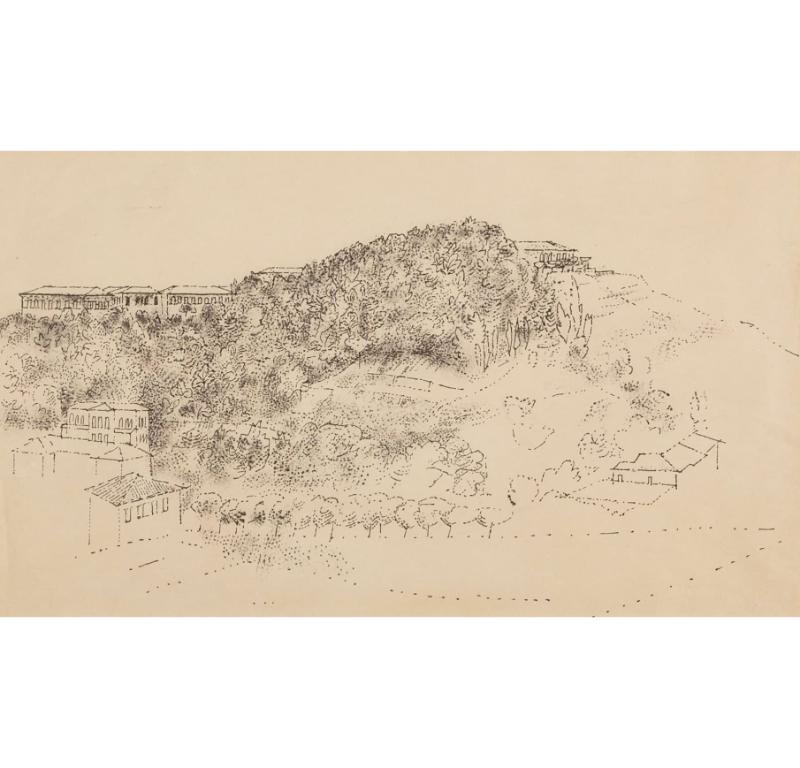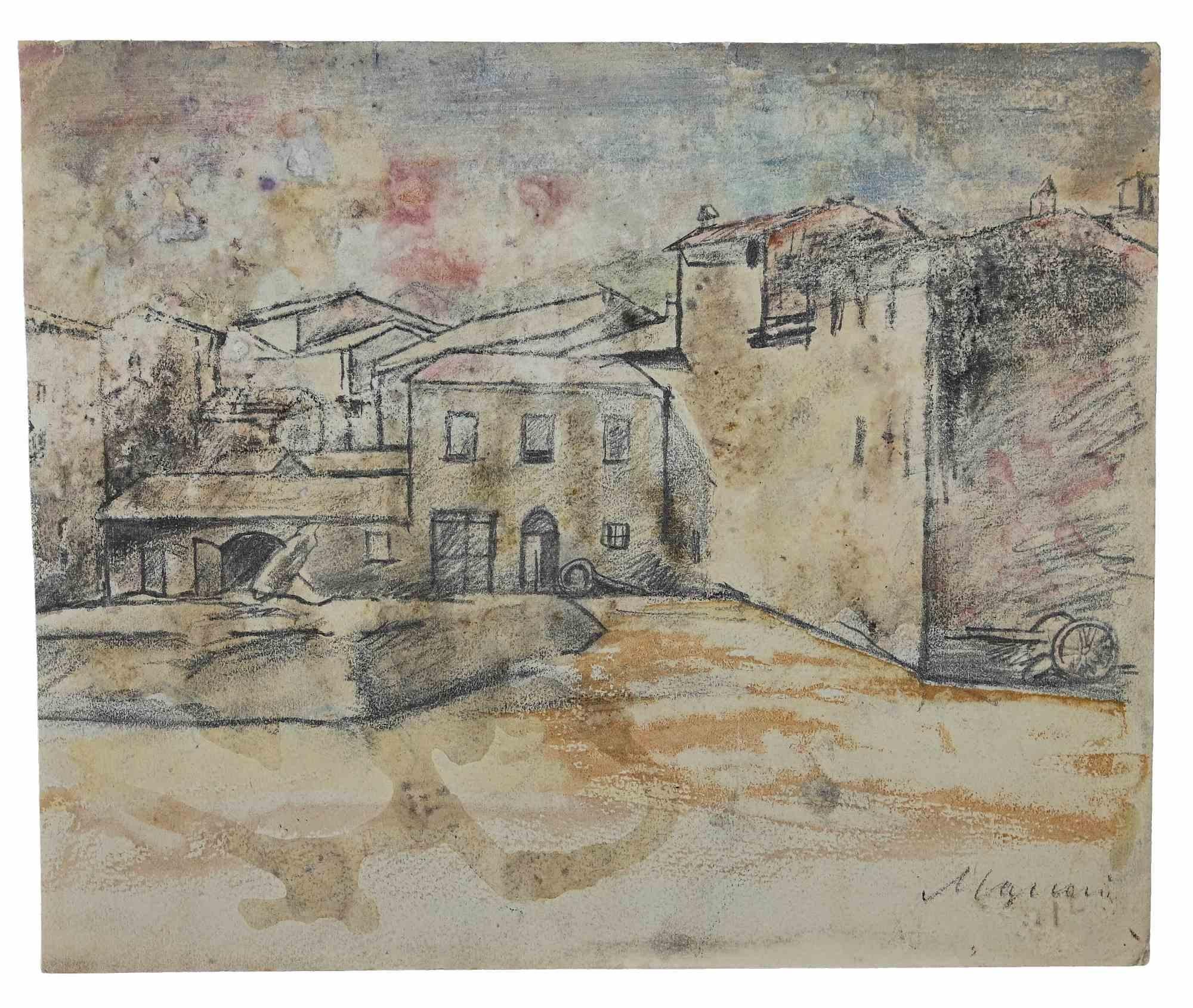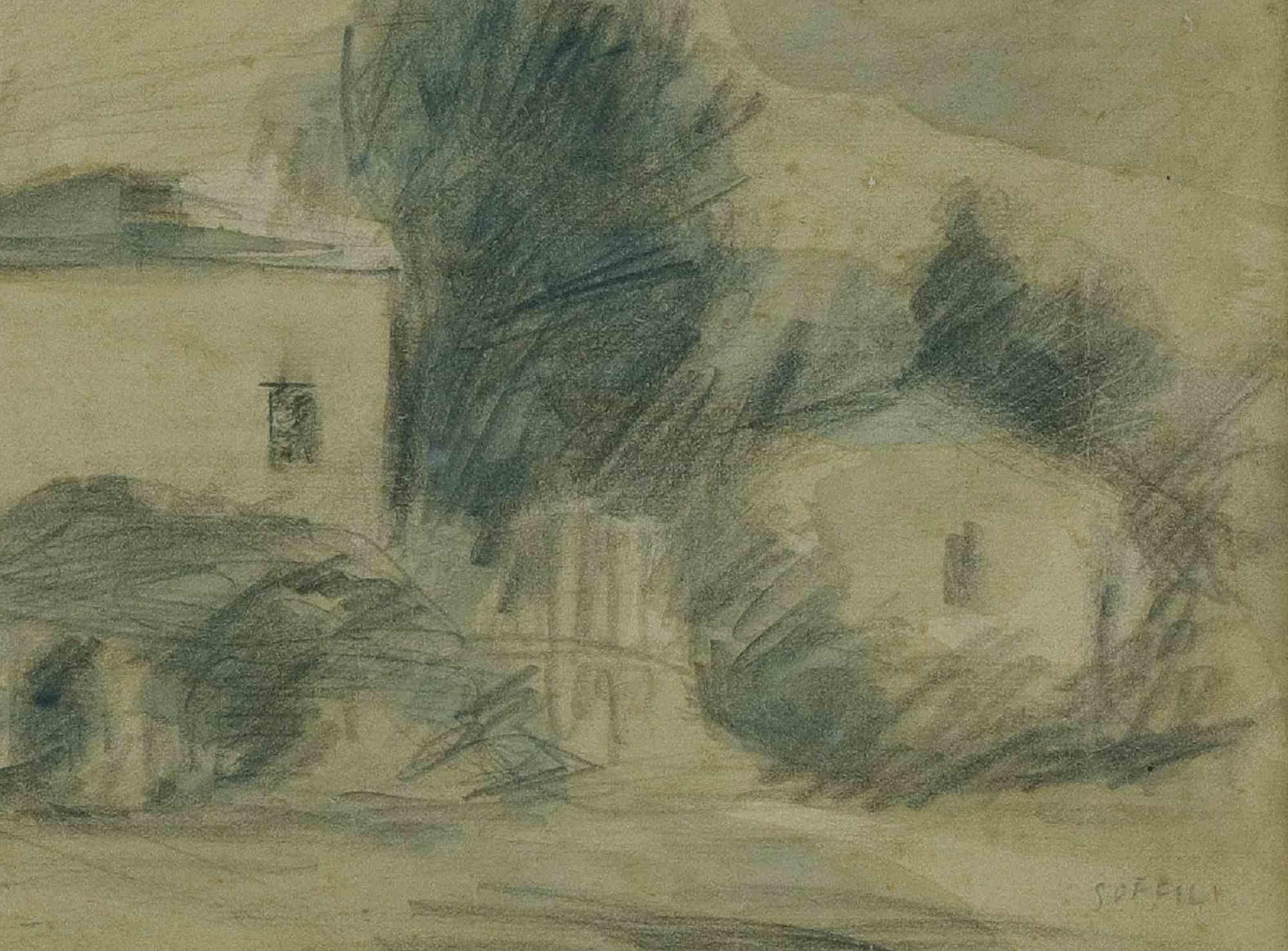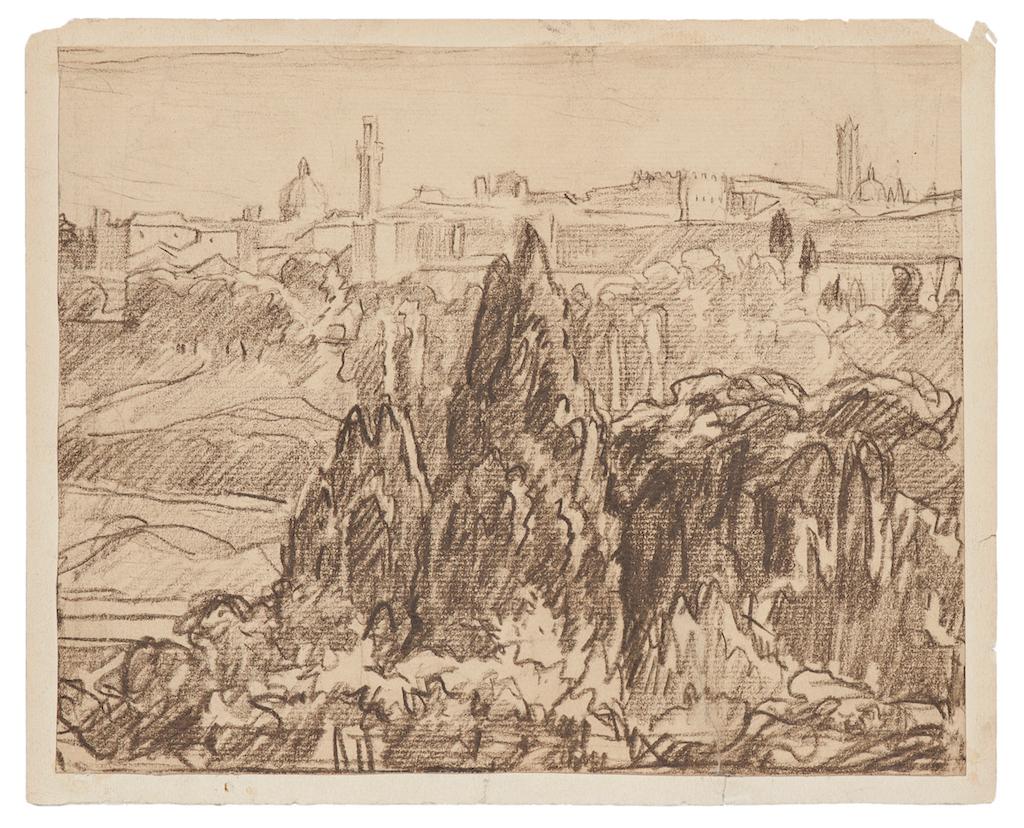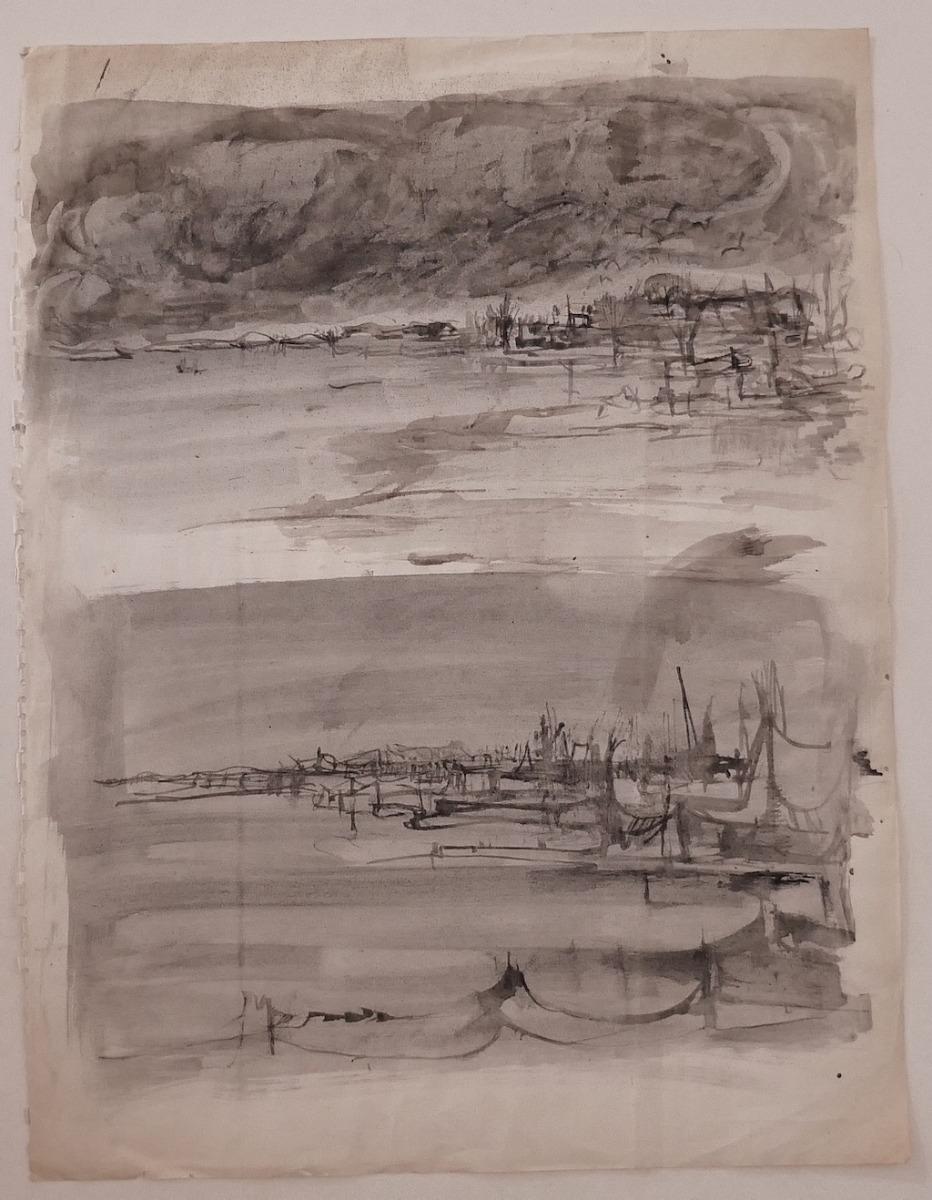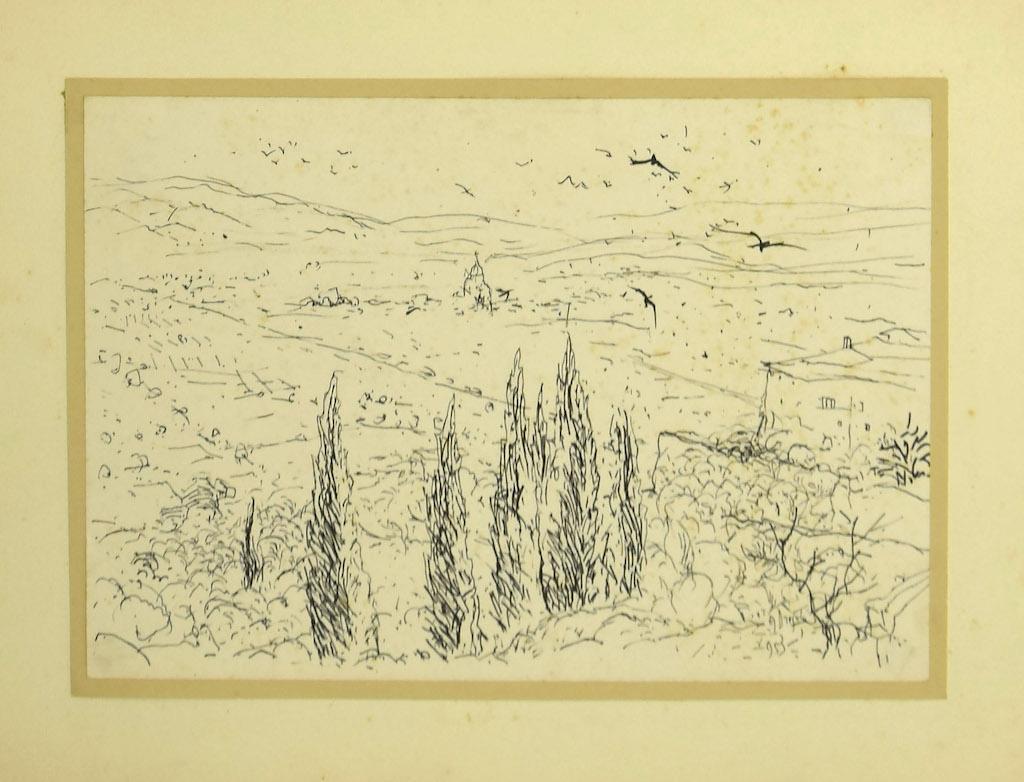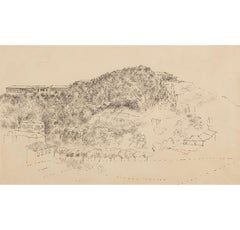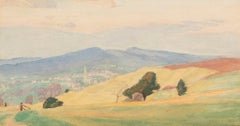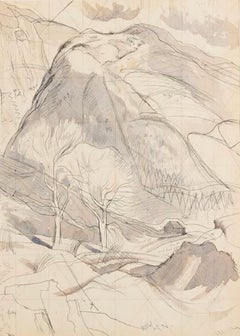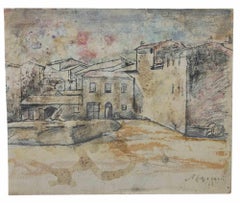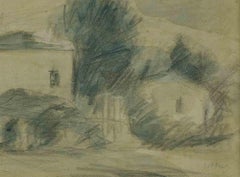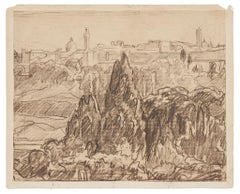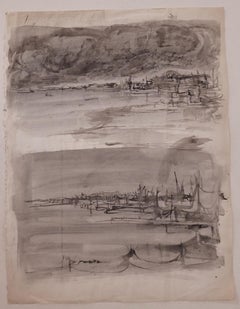Items Similar to Italian Scene, Pen and Ink with Wash Painting by Reginald Brill, 1950s circa
Want more images or videos?
Request additional images or videos from the seller
1 of 6
Reginald BrillItalian Scene, Pen and Ink with Wash Painting by Reginald Brill, 1950s circa1950 circa
1950 circa
$1,169.95
£850
€996.34
CA$1,597.21
A$1,776.83
CHF 931.44
MX$21,712.42
NOK 11,860.68
SEK 11,165.19
DKK 7,437.28
Shipping
Retrieving quote...The 1stDibs Promise:
Authenticity Guarantee,
Money-Back Guarantee,
24-Hour Cancellation
About the Item
Italian Scene, Pen and Ink with Wash Painting by Reginald Brill, 1950s circa
Additional information:
Medium: Pen and ink with wash
33 x 48.3 cm
13 x 19 in
Reginald " Reggie" Brill was a versastile 20th century artist and teacher.
Brill was born in London in 1902 and spent his early childhood there and in Yorkshire. By the time of the First World War, at the age of 13, he was living in lodgings in London, working in a City office and attending St Martins School of Art in the evenings. Considering his lack of education, winning a scholarship to The Slade (now part of University College London) in 1921 where he studied under Henry Tonks for three years, was a huge achievement.
On leaving The Slade he found patronage in Lincolnshire, but by the time of the General Strike (1926) he had returned to London and was working on Lansbury's Labour Weekly. He married Rosalie, also an artist, and in 1927 won the Prix de Rome in Decorative Painting. Following two years at The British School in Rome, Brill went to teach at Blackheath School of Art. During 1930 he spent three months painting in Egypt and it was there that he met Col. T G Gayer-Anderson, one of the twin brothers who were to bequeath The Little Hall in Lavenham as a hostel for art students. It was there that Brill retired to act as warden, thus continuing his nurturing of art students until his death in 1972.
Brill took up his appointment at The School of Art, Kingston upon Thames in January 1934. It was situated in the Technical Institute (Kingston Hall Road) and Brill found it bohemian and disorganised. He proceeded to inject enthusiasm, order and discipline. Within 5 years of his appointment a purpose-built School of Art was opened in Knights Park. It remained open throughout the war and by 1945 there was a waiting list for places. Under the skilled and totally dedicated direction of Brill, Kingston School of Art became established with national reputation for excellence. In 1961 Sir Charles Wheeler opened the new building at Knights Park. Costing £100,000, this more than doubled the size of the Art School.
Brill, was a well-known figure in Kingston. His eloquence made him popular as a guest speaker and his promotion of Art and Design stretched well beyond the doors of Knights Park. Apart from establishing two of the main buildings which makeup what is now known as the Faculty of Design, one of the most visible local contributions he made was the setting up of a topographical collection of paintings depicting Kingston, which has since become known as The Brill Collection at Kingston Museum. Brill gained huge respect and admiration from the hundreds of pupils who studied at Kingston during his 30-year leadership.
He published two books, Modern Painting 1946 and Art as a Career 1962, both bearing a strong educational angle. He regularly exhibited along with leading artists of his era at The Royal Academy, both his paintings and his acutely observed drawings. All the while he was a prolific artist, although reading his diaries, intensely self-critical. His perfectionism, acute powers of observation and relentless research can be seen in his drawings, which via the media and methods he explored throughout his life reflect mid 20th century British Art at its most typical. His major series of work, known as 'The Martyrdom of Man', was carried on in parallel to his career as a teacher. These paintings reflect his care for fellow man and depict people at work, e.g., The Operation, The Jury, Linemen, Waiting Room and Rest, which recently sold at Sotheby’s and was specially restored for The Brill Retrospective. His smaller works also play with the theme of everyday events and communication amongst people, such as The Bull Ring and Market Place paintings.
Brill's name is associated particularly with human figure compositions, but he also worked on landscapes, portraits and details of plants, animals, interiors etc. As one would expect he moved from one media to another, and his unusual hand painted and cut paper mosaics are beautifully designed and worked. The Englishness of his work, with its narrative theme and the emphasis on people in their environment, combined with his interest and concern in human behaviour results in a legacy of excellence as yet unexploited.
- Creator:Reginald Brill (1902 - 1974, English)
- Creation Year:1950 circa
- Dimensions:Height: 13 in (33.02 cm)Width: 19 in (48.26 cm)
- Medium:
- Period:
- Condition:
- Gallery Location:Kingsclere, GB
- Reference Number:1stDibs: LU2718214573372
About the Seller
No Reviews Yet
Vetted Professional Seller
Every seller passes strict standards for authenticity and reliability
Established in 2010
1stDibs seller since 2024
39 sales on 1stDibs
Typical response time: 15 hours
- ShippingRetrieving quote...Shipping from: Kingsclere, United Kingdom
- Return Policy
Authenticity Guarantee
In the unlikely event there’s an issue with an item’s authenticity, contact us within 1 year for a full refund. DetailsMoney-Back Guarantee
If your item is not as described, is damaged in transit, or does not arrive, contact us within 7 days for a full refund. Details24-Hour Cancellation
You have a 24-hour grace period in which to reconsider your purchase, with no questions asked.Vetted Professional Sellers
Our world-class sellers must adhere to strict standards for service and quality, maintaining the integrity of our listings.Price-Match Guarantee
If you find that a seller listed the same item for a lower price elsewhere, we’ll match it.Trusted Global Delivery
Our best-in-class carrier network provides specialized shipping options worldwide, including custom delivery.More From This Seller
View AllItalian Landscape, Pen Painting by Reginald Brill, 1950 circa
By Reginald Brill
Located in Kingsclere, GB
Italian Landscape, Pen Painting by Reginald Brill, 1950 circa
Additional information:
Medium: Ink
20 x 34 cm
7 7/8 x 13 3/8 in
Reginald " Reggie" Brill was a versastile 20th century artist and teacher.
Brill was born in London in 1902 and spent his early childhood there and in Yorkshire. By the time of the First World War, at the age of 13, he was living in lodgings in London, working in a City office and attending St Martins School of Art in the evenings. Considering his lack of education, winning a scholarship to The Slade (now part of University College London) in 1921 where he studied under Henry Tonks for three years, was a huge achievement.
On leaving The Slade he found patronage in Lincolnshire, but by the time of the General Strike (1926) he had returned to London and was working on Lansbury's Labour Weekly. He married Rosalie, also an artist, and in 1927 won the Prix de Rome in Decorative Painting. Following two years at The British School in Rome, Brill went to teach at Blackheath School of Art. During 1930 he spent three months painting in Egypt and it was there that he met Col. T G Gayer-Anderson, one of the twin brothers who were to bequeath The Little Hall in Lavenham as a hostel for art students. It was there that Brill retired to act as warden, thus continuing his nurturing of art students until his death in 1972.
Brill took up his appointment at The School of Art, Kingston upon Thames in January 1934. It was situated in the Technical Institute (Kingston Hall Road) and Brill found it bohemian and disorganised. He proceeded to inject enthusiasm, order and discipline. Within 5 years of his appointment a purpose-built School of Art was opened in Knights Park. It remained open throughout the war and by 1945 there was a waiting list for places. Under the skilled and totally dedicated direction of Brill, Kingston School of Art became established with national reputation for excellence. In 1961 Sir Charles Wheeler opened the new building at Knights Park. Costing £100,000, this more than doubled the size of the Art School.
Brill, was a well-known figure in Kingston. His eloquence made him popular as a guest speaker and his promotion of Art and Design stretched well beyond the doors of Knights Park. Apart from establishing two of the main buildings which makeup what is now known as the Faculty of Design, one of the most visible local contributions he made was the setting up of a topographical collection of paintings depicting Kingston, which has since become known as The Brill Collection at Kingston Museum. Brill gained huge respect and admiration from the hundreds of pupils who studied at Kingston during his 30-year leadership.
He published two books, Modern Painting 1946 and Art as a Career 1962, both bearing a strong educational angle. He regularly exhibited along with leading artists of his era at The Royal Academy, both his paintings and his acutely observed drawings. All the while he was a prolific artist, although reading his diaries, intensely self-critical. His perfectionism, acute powers of observation and relentless research can be seen in his drawings, which via the media and methods he explored throughout his life reflect mid 20th century British Art at its most typical. His major series of work, known as 'The Martyrdom of Man', was carried on in parallel to his career as a teacher. These paintings reflect his care for fellow man and depict people at work, e.g., The Operation, The Jury, Linemen, Waiting Room and Rest, which recently sold at Sotheby’s and was specially restored for The Brill Retrospective. His smaller works also play with the theme of everyday events and communication amongst people, such as The Bull Ring and Market Place paintings.
Brill's name is associated particularly with human figure compositions, but he also worked on landscapes, portraits and details of plants, animals, interiors etc. As one would expect he moved from one media to another, and his unusual hand painted and cut paper mosaics...
Category
20th Century Landscape Paintings
Materials
Pen
Painswick, Watercolour Over Pencil Painting by Charles March Gere, 1930s circa
By Charles March Gere, RA, RWS
Located in Kingsclere, GB
Painswick, Watercolour Over Pencil Painting by Charles March Gere, 1930s circa
Additional information:
Medium: Watercolour over pencil
15.5 x 29.5 cm
6 1/8 x 11 5/8 in
Signed and titled verso
Charles March Gere RA RWS was an English painter, illustrator of books, and stained glass and embroidery designer associated with the Arts and Crafts movement.
He painted his signal work in 1897 entitled The Lady of Grey Days.The painting was purchased in 1912 and given to Aurora Howard, a descendant of the Earl of Carlisle (of Castle Howard). It was last seen...
Category
20th Century Landscape Drawings and Watercolors
Materials
Watercolor
Mountain Landscape, Pen and Ink Drawing by John Nash, 1950s, Double-sided
By John Nash
Located in Kingsclere, GB
Mountain Landscape, Pen and Ink Painting by John Nash 1893-1977, circa 1950
Additional information:
Medium: Pen and ink, with another pen and ink with watercolour verso
29 x 21 cm
1...
Category
20th Century Landscape Paintings
Materials
Pen
Pastoral Landscape, Gouache and Watercolour Painting by Alan Reynolds, 1953
By Alan Reynolds
Located in Kingsclere, GB
Pastoral Landscape, Gouache and Watercolour Painting by Alan Reynolds, 1953
Additional information:
Medium: Gouache and watercolour
19.5 x 27.5 cm
7 5/8...
Category
20th Century Abstract Drawings and Watercolors
Materials
Gouache
On the Meldons Road, Watercolour Painting by William George Gillies, circa 1940s
Located in Kingsclere, GB
On the Meldons Road, Watercolour Painting by William George Gillies, circa 1940s
Additional information:
Medium: Watercolour
41.5 x 59 cm
16 3/8 x 23 1/4 in
Signed
William George G...
Category
20th Century Landscape Drawings and Watercolors
Materials
Watercolor
From the Calcina, September (Venice), by Peter Greenham, 1991
By Peter Greenham
Located in Kingsclere, GB
From the Calcina, September (Venice), Watercolour over Pencil Painting, 1991
Additional information:
Medium: Watercolour over pencil
15.2 x 21.6 cm
6 x 8 1/2 in
Signed, dated and titled on the reverse
Peter Greenham was a distinguished figurative painter of portraits, landscapes and incidents from domestic life. His work was both sensitive and intelligent and like himself, without showiness or pretension. He was keeper of the Royal Academy Schools and a popular figure who taught many well-known artists including Martin Yeoman, Peter Kuhfeld, Edmund Fairfax-Lucy and Jane Corsellis.
Greenham was born in Streatham and educated at Dulwich before studying English at Magdalen College, Oxford, followed by Fine Art at the Byam Shaw School of Art in Kensington from 1936-39 under the supervision of Ernest Jackson.
After leaving Byam Shaw he became a schoolmaster at Magdalen College School, Oxford and was elected an Associate of the Royal Academy in 1951 and an R.A. in 1960.
In 1964 he succeeded Sir Henry Rushbury as Keeper of the Royal Academy Schools, a position he held with distinction until his retirement in 1985. The Keeper has the responsibility of running the RA Schools and Greenham showed himself to have great sympathy and understanding for his students.
In retirement he was able to concentrate entirely on his painting and tended to paint places he knew well such as the Norfolk coast, Northumberland, Oxfordshire and Annecy as well as his wife, the painter Jane Dowling...
Category
20th Century Landscape Drawings and Watercolors
Materials
Watercolor
You May Also Like
Landscape - Charcoal and Watercolor By Mino Maccari - 1940s
By Mino Maccari
Located in Roma, IT
Landscape is an original Charcoal and watercolor realized by Mino Maccari in 1940s.
Good condition, hand-signed by the artis.
Some sketches of the artist on the back of the paper.
...
Category
1940s Modern Figurative Drawings and Watercolors
Materials
Charcoal, Watercolor
Landscape - Drawing by Ardengo Soffici - 1930s
By Ardengo Soffici
Located in Roma, IT
Landscape is an original modern artwork realized by Ardengo Soffici in 1930s.
Pencil on paper.
Hand signed lower right.
Includes frame.
Category
1930s Modern Figurative Drawings and Watercolors
Materials
Pencil, Pastel
Landscape - Charcoal Drawing on Paper by R. Santerne-Early 20th Century
Located in Roma, IT
Landscape is a beautiful original drawing on paper realized by Robert Santerne between the 1930s and 1940s.
Stamped on the rear "Atelier R.Santerne"
Aged conditions with repaired r...
Category
Early 20th Century Modern Figurative Drawings and Watercolors
Materials
Paper, Charcoal
Landscape - Watercolor on Paper by Rudolf Hausner - Mid-20th Century
By Rudolf Hausner
Located in Roma, IT
Landscape is a beautiful drawing in watercolor paper realized by Rudolf Hausner (1914-1995).
In aged condition a trace of folded.
The artwork represen...
Category
Mid-20th Century Contemporary Figurative Drawings and Watercolors
Materials
Watercolor
Landscape - Drawing Ink by Eugen Drăguțescu - Mid 20th Century
Located in Roma, IT
Landscape is an original drawing in china ink realized by Eugen Drăguțescu.
Hand-signed
Good conditions with some stains.
The artwork represents a landscape in a well-balanced com...
Category
Mid-20th Century Modern Figurative Drawings and Watercolors
Materials
Ink
Landscape - Drawing by André Léveillé - Mid-20th Century
Located in Roma, IT
Landscape is a drawing realized by André Léveillé (1880-1962) in the early 20th Century.
Charcoal and watercolor on paper.
Good conditions with slight foxing.
The artwork is reali...
Category
Mid-20th Century Modern Landscape Drawings and Watercolors
Materials
Charcoal
